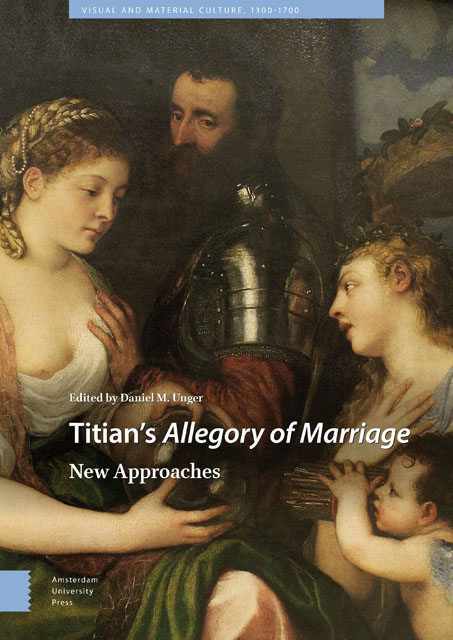Book contents
- Frontmatter
- Table of Contents
- List of Plates and Figures
- 1 Introduction: Poetic License
- 2 Love, Beauty, and the Human Body as a Reflection of the Divine
- 3 Amorosa visione: Titian’s Allegory of Marriage and the Poetry of the Half-length Format
- 4 The Arms and Armour of Titian’s Allegory of Marriage
- 5 ‘Un disio sol d’eterna gloria e fama’: A Literary Approach to Titian’s Allegory
- 6 Psyche, Venus, Ceres and Their Friends: Titian’s Remixes
- 7 Art and the Double Meaning of Reflection in Titian’s Allegory of Marriage
- 8 Titian’s Allegory of Marriage as an ‘Allegory of Peace’
- 9 Vision and Touch in the Allegory of Marriage
- 10 Of Crystal Orbs and Divinatory Mirrors : The Vicissitudes of Pregnancy and Artistic Agency in Titian’s Allegory of Marriage
- Index
5 - ‘Un disio sol d’eterna gloria e fama’: A Literary Approach to Titian’s Allegory
Published online by Cambridge University Press: 16 November 2022
- Frontmatter
- Table of Contents
- List of Plates and Figures
- 1 Introduction: Poetic License
- 2 Love, Beauty, and the Human Body as a Reflection of the Divine
- 3 Amorosa visione: Titian’s Allegory of Marriage and the Poetry of the Half-length Format
- 4 The Arms and Armour of Titian’s Allegory of Marriage
- 5 ‘Un disio sol d’eterna gloria e fama’: A Literary Approach to Titian’s Allegory
- 6 Psyche, Venus, Ceres and Their Friends: Titian’s Remixes
- 7 Art and the Double Meaning of Reflection in Titian’s Allegory of Marriage
- 8 Titian’s Allegory of Marriage as an ‘Allegory of Peace’
- 9 Vision and Touch in the Allegory of Marriage
- 10 Of Crystal Orbs and Divinatory Mirrors : The Vicissitudes of Pregnancy and Artistic Agency in Titian’s Allegory of Marriage
- Index
Summary
Abstract
In the early seventeenth century, Titian's Allegory of Marriage was interpreted as the Allegory of Alfonso d’Avalos, the Marquis del Vasto. Yet, in modern times, scholars have agreed that the d’Avalos identification as the male protagonist in this painting is rather problematic. In this chapter, I argue that Titian's Allegory is a representation of a poet-soldier, probably inspired by the literary image of Julio in Angelo Poliziano's Stanze (1478), as well as by members of the military elite, d’Avalos's peers, whose commanders embraced the ethos of ‘arms and letters’ and whose poems often reflected a departure from a beloved.
Key Words: Titian, Alfonso d’Avalos, poet-soldier, Poliziano, Le Stanze, Vittoria Colonna.
In Titian's Allegory of Marriage, a man in armour is departing from his sad lady (Plate 1). He is leaving for war in gleaming armour that reflects two images: one of his lady, his muse of poetry, which is mirrored on his chest, and the image of Minerva, his guide in warfare, which seems to be mirrored on the other side of his shield (Plate 6).
Titian's departing warrior is a representation of a poet-soldier. Alfonso d’Avalos, the Marquis del Vasto, embodied this concept. He was a commander in the service of the Holy Roman Emperor Charles V and his frequent departures from his beloved wife, Maria d’Aragona, were documented in his poem Anchor che col partire (‘Although in Leaving’), which was printed in 1547. Despite his popularity, his story was not the exception, but rather the rule among his peers: the members of a military humanistic elite, who combined military careers with the study of the humanities and/or literary endeavours. They were known for living by the ethos of ‘arms and letters’, a concept dealt with in Baldassare Castiglione's Libro del Cortegiano, published in Venice in 1528, where it was presented by the poet and clergyman, Pietro Bembo, who declared that arms and letters are equally important as noble accoutrements of the ideal courtier. Bembo's personal relationship with Titian is discussed by Valery Rees in the Chapter 2 of the present book.
In this chapter, I interpret Titian's departing warrior as a representation of a poetsoldier by focusing on the literary image of Julio, the principal character in Poliziano's Stanze, who, guided by Cupid, Minerva, and Glory, turns from a poet into a soldier, leaving his muse behind and heading out for the joust.
- Type
- Chapter
- Information
- Titian's Allegory of MarriageNew Approaches, pp. 109 - 130Publisher: Amsterdam University PressPrint publication year: 2022



